| Duntrekker | |
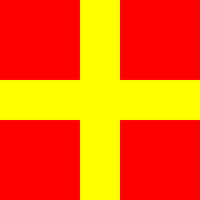 The Godenmarkeren, the traditional Duntrekker flag | |
| Total population | |
| 80 million | |
| Regions with significant populations | |
| 60-65 million | |
| 1-2 million | |
| 5-6 million | |
| 750,000-950,000 | |
| 700,000-800,000 | |
| 600,000-700,000 | |
| 200,000-250,000 | |
| 33,000-34,000 | |
| Languages | |
| Duntrekaans, Dundorfian | |
| Religions | |
| Amelioritism | |
| Related ethnic groups | |
| Dundorfians, Hulstrians, Luthorians, Nariks | |
Duntrekker people or Duntrekkers are an ethnic group of Dundorfian descent, inhabiting various areas of Artania, Seleya,and Majatra. They are known for their deep religious faith, simple lifestyle and skills of settlement anc colonization. The Duntrekkers left Dundorf for other parts of Terra in the 1600-1700s, for a variety of reasons and remain a distinctive ethnic group to this day.
History[]
The history of Duntrekkers began in 1519 when merchant-turned-Minister Gert van Tassel (Dundorfische: von Tossel) returned from an eight-year business assignment in Luthori where he had been exposed to, and converted to, Confessional Luthorian Hosianism.
Origin[]
Van Tassel and his family settled in the small village of Treptow, Markerburg and began seeking converts to the new faith. It was among the small shop owners and independent farmers of the area where van Tassel gained his first converts which allowed him to collect enough funds to construct what would become the first Ameliorate Hosian Church and thus create the first Confessional and Ameliorate community in Dundorf in 1523.
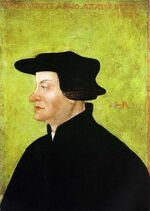
Gert van Tassel
Persecution[]
This initial small community spread to three neighboring villages (Gnößen, Wurtburg, Vern) and soon numbered about 16,000. This influx in numbers brought the community to the attention of the Apostolic Church and the landed gentry. These two groups joined forces to crush Van Tassel's movement through persecution, intimidation and exclusion. Often, Apostolic clergy would rally nobles and peasants alike to banish suspected Protestant converts from villages and farms; effectively casting them into the wilderness by cutting them from all familial and social ties.
Soon, the converts began to form themselves into small theocratic communities for mutual aid and protection; creating newer and stronger familial and social ties in the meantime.
Dunnische[]
It was within these small and excluded communities where the term Dunnische was coined for the first time. Its origins are unclear but it is believed to have been coined by members of the converted merchant community to describe themselves to "foreigners" (at the time, people of the different länder of modern Dundorf were considered foreigners to each other).
The term was eventually hijacked by the Apostolic Church and other groups as a label to differentiate between the Catholic "us" and the Ameliorate "them". It seems the Dunnische themselves turned the phrase around and began using it as a symbol of pride and religious conviction.
Advancement[]
In 1530, King Gerhard I issued the Bekennenden Gesetze (Confessing Laws) of 1530 which compelled nobles and the Apostolic Church to tolerate Dunner existence while forbidding the further conversion of Catholics to Independent Confessional Christianity.
With the insistence of the Apostolic Church further stricter laws were soon implemented "encouraging" (often with force) Dunnische resettlement to specified areas within Markerburg. At the time, a quite substantial number estimated at 30,000 peasants, freeholders, and low noblemen and their families were resettled. Due to this near total isolation, a new language, classified as Duntrekänische (Duntrekaans), formed amongst this group and a totally separate set of political and religious beliefs developed.
Pogroms[]
Legal protection for the Dunnische ended with the election of King Harold I and directly led to the "Pogrom of 1537". While violence and murder against individual Dunnischen was not uncommon, 1537 saw the first major attack on a Dunnische community since its inception nearly two decades earlier.
On Easter Sunday 1537 a mob of Catholic peasants, inspired by their Catholic clergy's sermons of rumored ritual murder and sexual perversion, marched to Wurtburg in the heart of the Dunner resettlement area. The mob quickly looted and sacked the town before chasing the townspeople to the nearby village of Tasselburg. There, the mob brutally tortured and murdered four hundred Dunnische men and raped dozens of women before violently looting the lone church, slaughtering its livestock and torching the village including its nearby grain fields and orchards.
Many smaller pogroms and isolated acts of violence continued throughout the sixteenth century but became less and less common as more of the peasantry converted. By 1610, almost half of the peasantry of Dundorf classified themselves as Reformed Protestant. The new Independent Confessional Christianity of the regular peasantry was not considered the same as that practiced by the Dunnischen, however.
The new Independent Christianity sweeping through the kingdom was brought from abroad through various ministers and was classified as more a universal and "friendlier" faith than the Dunnische denomination. Theologists point to the period of persecution, exclusion, and isolation of the Dunnische as culprits in their rather dark and wrathful interpretation of God and religious scripture. It was because of this adherence to isolation and foreboding scriptural interpretation that contributed to the continued discrimination and alienation of the Dunnische despite the enormous growth of Independent Confessionalism in Dundorf.
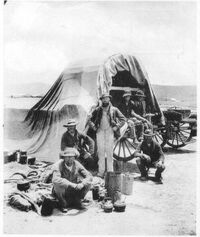
Members of a trek posing for the camera after having set up camp for the night.
Die Groot Trek[]
Throughout the 17th and 18th centuries, the younger generations of Dunnische grew wary of the political and economic restrictions still in place upon them. These generations were supported in their efforts by like-minded ministers who preached Dunner exceptionalism and the apparent Dunnische covenant with God to create a religious "city on a hill" free from outside influences.
Modern scholars have termed this "Pandunnischismus" (Dunnische nationalism), "Dunnische destiny", or the "Dunnische Covenant". They have also cited, however, the overpopulation of the Dunnische areas in Markerburg and the need to stem the waiting demographic disaster as an additional cause of the "Great Trek".
Soon, brave young Dunnische families left their homeland and ventured into Terra on their people's "Exodus" in search of their respective "Canaan" for which God had promised them in their Covenant; the very land where they were to build their "New Jerusalem" upon a hill. In 1790, Reverend Piet van Merwerzuider led the largest of these "treks" bringing with him nearly 350 families totally around 16,000 people to Saridan.
In what became known as the Groot Trek, the newly-dubbed Duntrekkers departed Artania via Rutania, Aloria, or Kirlawa and sailed to various locations across Terra; notably Saridan, Likatonia, Pontesi, and Malivia. In those nations - many of which were sparsely populated and lacked real governments - they could build new pious and wealthy lives as rural farmers or ranchers.
The term "Duntrekker" soon became synonymous with anyone directly associated with the community. The old term "Dunnische" was almost forgotten, even in Dundorf, but is still often used by Duntrekkers abroad to distinguish those who stayed behind to themselves.
Duntrekkers Abroad[]
The Duntrekkers settled in their new homelands forming isolated, small, tightly-knit farming communities. These settlers were staunchly religious, worshiping the very wrathful God they had left behind in Dundorf.
Duntrekker attempts at converting the indigenous peoples of their new homelands brought little success and most Duntrekker communities agreed to abandon such efforts and focus instead on preserving their culture through isolation.
As Dundorf was uninterested in the affairs of overseas refugees, and the poor state of communications made continued contact with the old Dunner communities in Markerburg, the Duntrekker began to develop distinct cultures based upon their adopted homelands. As a result, the many different dialects of Duntrekaans (Duntrekänische) and the different traditions of the Duntrekker communities took shape, forming the distinct and yet diverse culture.
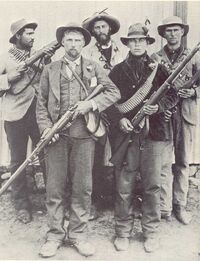
Standard Duntrekker militiamen in Pontesi.
Conflicts[]
In most places, Duntrekker communities abroad lived in relative peace. However, during the late 1800s there were problems in many of their adopted homelands. Around the turn of the century, several nations hosting the "Trekkers" engaged in small-scale warfare in hopes of re-acquiring their lost lands. In many areas, the Duntrekkers were under constant siege, which greatly influenced their political, religious and cultural mindsets.
The Duntrekker Guerilla[]

Dead Likaton militia after an unsuccessful attempt at pushing Duntrekkers off their land.
As Duntrekker communities were small and sporadic they had to rely on themselves for their own defense. The Duntrekker militia was almost exclusively a defensive force as was rarely used as an invasion tool. Because of this, the typical Duntrekker militiaman was highly motivated to protect his homeland even though he may not have necessarily been highly trained. He was often a local man who knew the area very well, giving him a great advantage over any invading army.
The necessity for constant diligence and defense required to protect not only their livestock from roving predators but also their communities from invaders forced all Duntrekker men -- and many women -- to become proficient with firearms at a young age. Boys as young as twelve were often recruited into local militia forces where they would fight alongside their neighbors and kin.
The rifle has held a sacred place amongst many besieged Duntrekker communities and men, upon reaching adulthood, would often be given the last rifle as a rite of passage. This, along with hunting, made most Duntrekkers militiamen very deadly with their rifles, especially at long ranges.
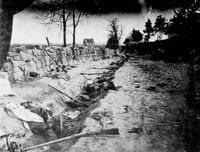
Duntrekker dead in "Blood Alley" outside of the small trek village of Nelspruit in Malivia on 9 May 1898. The Duntrekker militia in the country attempted to fight against the Malivian army conventionally with disasterous results. It is still remembered in Malivian Duntrekker lore as "De Daag van Traannen" ("The Day of Tears").
The militia's small numbers, high motivation, knowledge of the ground, knowledge of weaponry, horsemanship and a supportive civilian population made them excellent guerilla fighters using hit-and-run tactics to great effect.
The Trek Wars[]
Most violent conflicts between Duntrekkers and their neighbors were short with both sides experiencing success in battle, and were often ended through negotiated settlement where the status quo was maintained with only minor changes in borders or position, if any change at all.
Malivia: The Trek War of Maliva was the longest and most destructive conflict the Duntrekkers ever faced. It was a sporadic, yet violent, guerilla war lasting from 1886-1899. For the first ten years, the Duntrekkers experienced relative victory over the Malivian government. They had held off government advances, kept their militias relatively intact, and had suffered few casualties; both civilian and military.
However, in 1897, the Malivian army changed tactics and began targeting the civilian population by destroying, first, isolated Duntrekker homesteads, and then, whole Duntrekker villages. By denying the Duntrekker militias their home bases, their food supplies, and their families they hoped to weaken Duntrekker resistance. Using overwhelming numbers and attacking many areas at once, the Malivian army was able to wear thin the Duntrekker militas.
Unable to cope with the humanitarian crisis, the rising militia losses and exhaustion, the Duntrekkers were forced to capitulate and subsequently disarmed before being shuffled off to reservations.
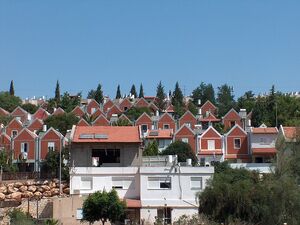
Modern Duntrekker settlement in the warm climate of Dendars, Malivia. Notice the simplicity and the uniformity of the structures. Not pictured here is the church; centerpiece of the village and villager life.
Saridan:
Duntrekkers Today[]
Despite conflict in many of their adopted lands, Duntrekkers remained and are still present in those nations today. Most still tend to live self-sufficiently in small community and isolated homesteads. Many also have retained their strict-conservative religious beliefs. Although many have moved into cities using their tradition of business management to gain success in the business world.
For the most part, Duntrekkers tend to be relatively poor in comparison to many of their neighbors in their adopted homelands. However, they make up for this in their strong social cohesion and religious conviction.
Culture[]
As mentioned earlier, the Duntrekkers are staunchly religious Confessionalists practicing their particular brand of Amelioratism derived from their experiences with persecution over the centuries of their existence. Many practice beliefs unpopular in their ethnic homeland; this contributed to their exodus in the first place. They try not to associate themselves with outsiders too much, but often attempt to spread their beliefs as missionaries. No Trekker village is without at least one church.
- culture & traditions vary between the national origins of Duntrekkers
- Duntrekkers in Saridan, Dundorf, Pontesi, Rutania, Aloria, Likatonia, Malivia, Kirlawa have different cultures, traditions & customs; some have few differences between them, others are so dissimilar as to be nearly unknown to each other
- however, some similar traits--
Land Ownership:
- land ownership considered important; hard work valued; not uncommon to fix up "poor" land and make it fertile
- The Trekkers traditionally work in the agricultural sector; some communities are especially skilled in livestock while others are better farmers; They raise all kinds of animals, depending on their homeland.
- in drier areas, very skilled in irrigation
- different crops grow in different areas; good mix to food crops and cash crops
- recent centuries Duntrekkers participate in various occupations; strong in business
Various communities have adapted to climate: Dandratur (Pontesi) local Makaaners engage in olive growing herding in Mediterranean climate; Dendars of Malivia grows major crops in tropical climate like bananas, papayas, rice, sugar and excellent farming techniques of Duntrekkers; Rutania's Bozarland around the city of Spaak.
Dress:
- Varies depending on the climate, environment, & nation of origin; however, similar traits
- dress in very simple, typically dark/neutral color clothing.
- Tropical areas, men often wear wide-brimmed hats; thick boots and long trousers.
- Women dress conservatively, preferring somewhat old-fashioned but simple dresses or work clothes to modern styles.
- often try to distance themselves from locals, preferring to maintain their own culture while giving little trust to their hosts.
- because of this, Trekkers often possess xenophobic and/or racist attitudes; and this has earned them disdain in many of their home countries.
- such xenophobia/racism has been toned down in recent centuries
- most share general distrust of outsiders; however, warm to other Duntrekkers from anywhere, regardless of their respective cultures
- strong bonds between communities; while outsiders are looked upon with suspicion, Duntrekker strangers from any Duntrekker area in Terra are welcome in almost every home
- live separated from most of society; but this is deceiving, many interact with the world through business and work; children typically attend public schools (depending upon parents however) and there is much interaction between Trekkers and outsiders; however, Duntrekkers tend to live in close proximity to one another
- family is very important, ties very strong; married adult children tend to live near husband's family
- if Duntrekker leaves community generally single men and women
- it is highly looked down on for Duntrekker men and women to marry outsiders
"Tasselism" Theology[]
- important to understand how the religion evolved.
- The core ethos was and has been to escape persecution; their development model was based on a very insular, inward-looking civilization, one that feared the outside
- strive for moral purity of all aspects of life; emphasis on trustworthiness as a form of grace
- emphasis on individual and business conformance to Bible & Hosian teachings; morality involved in business & business performance; Duntrekkers consistently rank amongst the most trustworthy business ventures in Terra
- specific roles of men and women, go back to Bible and original sin
- worship in church strictly regulated by what is in Bible
- believe themselves to be the chosen people of God; a Covenant exists to create a new Yerusalem in a new Kanaan which explains the numerous Treks
- persecution was bestowed upon them as a test of their faith
- created strong bond between communities
- No separation of Church and State; they are one in the same
- An emphasis on private study of the Bible
- The priesthood of all believers
- Simplicity in worship, the exclusion of vestments, images, candles, etc.
- Did not celebrate traditional holidays which they believed to be in violation of the regulative principle of worship.
- Believed the Sabbath was still obligatory for Hosians, although they believed the Sabbath had been changed to Sunday
Religious Practices[]
- presided over by a Teaching Elder
- Presbyterian organization: elders run local church
- Believe God, People, and State should be one and the same -- called "Tasselianism"; different than the rest of Dundorfian Amelioratism
The typical Duntrekker village is small, roughly 80-250 members and contains a small, plain-looking church. The village church is presided over by a Begeleideprediker (Guided-preacher) who normally has spent several decades studying scripture, discussing theology, and learning religious traditions with elder preachers. However, since the process of earning a "preacherhood" is time-consuming and immensely difficult the number of qualified preachers is few and therefore it is not uncommon for a collection of village elders to preside over sermons and church services; the idea being that several experienced elders together have enough knowledge to carry out a sermon. Major services such as weddings, funerals, and baptisms must be performed by a qualified Begeleideprediker.
Typical service: - short sermon
- hymn singing; some more rigid communities (mostly non-Dundorfian) see hymn singing as sacriledge and instead read Psalms as poetry
- long sermon
- blessings (preacher discusses events around the village such as animal births, child births, anniversaries, harvests, etc and has "congregation" thank God for these blessings), the idea is to allow the community to "see" how God has helped and blessed them
- communion = given twice yearly; and on special occasions such as baptism, weddings, or funerals
- baptism = adult baptism is most common in Old Believers (mostly Dunners in Dundorf); Duntrekkers in foreign lands tend to baptize "breeched" boys (about 5 years old) and girls upon reaching puberty (often considered age 12 regardless of physical puberty)
Militarization[]
Initially, Dunners preached non-violence, taking Eliyahus' commandment of "turn the other cheek" literally. When the communities faced persecution and the eventual pogroms in Dundorf they suffered quietly; sticking to their adherence to non-violence.
- "Violent" Duntrekkers mostly outside Dundorf, Dunners of Dundorf tend to be more peaceful in teaching
- Duntrekkers still engage in self-defense; community and independent militias (legal and illegal) exist; last several centuries, Duntrekkers began participating in various national militaries, often overrepresented in the officer corps and special forces for their population
Sport[]
- Dunnische developed a rough & tumble game similar to rugby in Dundorf
- Great Treks spread the game around; eventually, all communities adopted the new rules of Rugby imported from Kanjor over a period of time stretching from the 1860s to the 1870s
Family[]
- large families believed to be blessing from God
- father traditionally head of household; but more recent studies have shown that throughout its history women involved in nearly all major decisions; often behind the scenes
- women hold de jure equality in public; but de facto at home and within family
Courting and Marriage[]
- Not individual courtship; "group dating" instead
- reasons: small villages and isolated farmsteads, few eligible mates; communities agree to have all eligible young adults (normally 15/16 or older) come together for Samahoringhid (Togetherness); this expands socialization outside of the normal village setting - very formal affairs, heavily chaperoned, much hymnal singing, boys and girls separated by rope down the middle of barn/meetinghouse; only get to meet face-to-face in last fifteen minutes
- if couple gets together, must be approved by both families (which is normally a formality); then pass through phase known as Het Voorspellen (The Knowing) in which couples learn more about each other through a series of chaperoned "dates" with each others family members
- The Knowing has been described as being similar to interviewing for a job
- marriage normally takes place after the fall harvest or equivalent (may vary, some Duntrekkers reside in places without four seasons but may have dry and wet seasons)
- bride wears yellow; groom wears green -- no engagement ring but instead blue ribbon tied around waist of bride and groom
- wedding: wedding ring presented (gold bands, no stones); long sermon, long ceremony with hymns and explanation of marital requirements; wedding night spent with groom's parents although this has changed in most communities
Funeral[]
Language[]
Duntrekkers primarily speak the Duntrekaans language, which is related to a Southern Rhaetan language, closely related to Vanukeaans and Narik.
Names[]
Several extended families make up much of the Trekker population, though numerous smaller ones exist as well. Family names often begin with Van or Van Der (meaning 'from'). A place-name, often located in northern Dundorf, will follow. Some families changed their names to suit their new homes. Some of the best-known last names are:
- Van Tassel
- Van Der Grootfontein
- Bezuidenhout
- Von Dungrau
- Groetelzuiderhein
- Mernderwar
- Weisserderrand
| Malivia articles | ||
| History | Malivian Imperium | |
| Geography | Greabok | |
| Politics | Political parties | |
| Demographics | Ethnic groups: Malivians Religion: Geraja | |
| Culture | Sport - Armed Forces | |
| Economy | Banking | |
| Saridan articles | ||
| History | Slavery stand-off | |
| Geography | Administrative divisions - Cities - Kidnarrie River - Lake Murumulada - River Jilber - Shallows | |
| Politics | Elections - Judiciary - Legislature - Political parties - Supreme court | |
| Demographics | Ethnic groups: Duntrekkers, Euphitriens, Iftgoerroon, Ikpis Religion: Restored Ameliorate Church of Saridan, Theognosian Church | |
| Culture | Sport - Armed Forces - Education | |
| Economy | Banking | |

|
Pontesian Dynastic Commonwealth Dawnstar (capital) | |
| History & Economy | History of Pontesi, Pontesian Civil War | |
| Geography | Migrant's Pass | |
| Demographics | Arev Mardik, Seluco-Pontesians | |
| Culture | National Anthem: Oh Fatherland | |
| Religion | Aurorian Patriarchal Church, Terran Patriarchal Church | |
| Satrapies | Bazileum | Septentria | Caespasia | Azorium | Mitraeum | |
| Politics | Historically Important Parties: Democrat Party, One Nation Conservative Party, Aurora Libertatis, Pontesi Socialistic National Unity Party, Crimson Crusade | |
| Nobility | Noble Houses: House of Belknap, House Mederagaar, House Aedinius | |
| People | Alamar Xarfaxis | |
